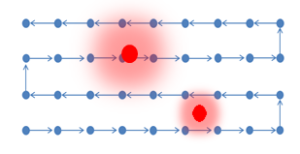 |
Professor B.A., Pomona College (1968) Ph.D. Stanford University (1974) Fellow, American Physical Society |

Fairbank group photo 2022
Search for Majorana Neutrinos in EXO-200 and nEXO
Our group is involved in the quest for one of the great unknowns of particle physics: are the neutrino and antineutrino the same particle (Majorana neutrinos) or are they distinct particles (Dirac neutrinos). The only known way to test this with currently conceivable technology is Neutrinoless Double Beta Decay (0nbb). If and when 0nbb decay is observed, it will demonstrate that neutrinos are Majorana particles, that the law of Conservation of Lepton Number is violated and give initial evidence for physics beyond the Standard model of elementary particle physics.
Neutrinoless Double Beta Decay
To date, 0nbb decay has not yet been discovered. Since 2005, our group has been part of the EXO-200 experiment, which has set a stringent limit on the half-life of 0nbb decay of 3.5×1025 years [1]. The EXO-200 0nbb detector uses 200 kg of isotopically enriched liquid Xe-136. We also work on the next generation EXO experiment, called nEXO, that expected to use about 5 tons of enriched liquid Xe-136 and to run for ten years. Its projected half-life sensitivity is greater than 1028 years [2].
Single Barium Daughter Atom Detection
Current 0nbb decay searches detect the total energy of the two energetic electrons emitted. While very powerful at distinguishing potential 0nbb events from similar-appearing background events, typically a small number of indistinguishable events limit the achieved sensitivity. If there were a way to detect the existence of a Ba-136 daughter atom or ion or not at the decay site of a potential Xe-136 0nbb decay event, complete distinction between 0nbb decays and background events, that don’t produce a Ba-136 daughter, could be obtained, enhancing the 0nbb search sensitivity significantly. [2] This is called Barium Tagging. Our group has been pioneering Barium tagging for more than two decades [3] and is the only group in the world that has achieved published images of single atoms to date. [4]. Images from our work are shown below. The ability to image and count single atoms or ions in solid noble gases has attracted interest from other groups for quantum computing [4] and a measurement of a very weak nuclear reaction that is a crucial bottleneck in the creation of the elements in the universe [5].

Moving a focused laser beam in a raster scan across a solid sample with a few Ba atoms deposited in the scan region.

As the laser moves from left to right, the signal increases abruptly when the laser is positioned at the location of the barium atom.


A “composite image of total Ba fluorescence vs. laser position. Two Ba atoms found in this scan of the sample can be easily counted. When we then parked the laser on the first peak, the signal suddenly turned off to “no barium” background (red points) after about 20 s. We have also seen the fluorescence “blink” off for a few image frames and then turn back on again.
References
[1] G. Anton et al., “Search for Neutrinoless Double-Beta Decay with the Complete EXO-200 Dataset”, Phys. Rev. Lett. 123, 161802 (2019).
[2] G Adhikari, et al., “nEXO: Neutrinoless double beta decay search beyond 1028 year half-life sensitivity”, J. Phys. G: Nucl. Part. Phys. 49, 015104 (2022).
[2] M. Moe, “Detection of neutrinoless double beta decay”, Phys. Rev. C 44, R931 (1991).
[3] B. Mong et al., “Spectroscopy of Ba and Ba+ deposits in solid xenon for barium tagging in nEXO”, Phys. Rev. A 91, 022505 (2015).
[4] C. Chambers et al., “Imaging individual Ba atoms in solid xenon for barium tagging in nEXO”, Nature 569, 203 (2019).
Recent publications
Ba tagging
- Twelker et al., “An apparatus to manipulate and identify individual Ba ions from bulk liquid Xe”, Rev. Sci. Instrum. 85, 095114 (2014). [arXiv:1407.0618].
- Mong et al., “Spectroscopy of Ba and Ba+ deposits in solid xenon for barium tagging in nEXO”, Phys. Rev. A 91, 022505 (2015). [arXiv:1410.2624]
- Brunner et al., “An RF-only ion-funnel for extraction from high-pressure gases”, Int. J. Mass Spec. 379, 110 (2015). [arXiv:1412.1144]
- Chambers et al., “Imaging individual Ba atoms in solid xenon for barium tagging in nEXO”, Nature 569, 203 (2019). [arXiv:1806.10694]
- Murray, et al., “Characterization of a Spatially Resolved Multi-Element Laser Ablation Ion Source”, Int. J. Mass Spect. 472, 116763 (2022). [arXiv:2108.10758]
EXO-200
- B. Albert et al., “An improved measurement of the 2nbb half-life of 136Xe with EXO-200”, Phys. Rev. C 89, 015502 (2014). [arXiv:1306.6106]
- B. Albert et al., “Search for Majorana neutrinos with the first two years of EXO-200 data”, Nature 510, 229 (2014). [arXiv:1402.6956].
- B. Albert et al., “Search for Majoron-emitting modes of double-beta decay of 136Xe with EXO-200”, Phys. Rev. D 90, 092004 (2014). [arXiv:1409.6829]
- B. Albert et al., “Investigation of radioactivity-induced backgrounds in EXO-200”, Phys. Rev. C 92, 015503 (2015). [arXiv:1503.06241]
- B. Albert et al., “Measurements of the ion fraction and mobility of alpha and beta decay products in liquid xenon using EXO-200”, Phys. Rev. C 92, 045504 (2015). [arXiv:1506.00317]
- B. Albert et al., “Search for 2νββ decay of 136Xe to the 01+ excited state of 136Ba with the EXO-200 liquid xenon detector”, Phys. Rev. C 93, 035501 (2016). [arXiv:1511.04770].
- B. Albert et al., “Cosmogenic Backgrounds to 0νββ in EXO-200”, J. Cosmol. Astropart. Phys. 04, 029 (2016). [arXiv:1512.06835].
- B. Albert et al., “First Search for Lorentz and CPT Violation in Double Beta Decay with EXO-200”, Phys. Rev. D 93, 072001 (2016) [arXiv:1601.07266].
- G. Davis et al., “An Optimal Energy Estimator to Reduce Correlated Noise for the EXO-200 Light Readout” JINST 11, P07015 (2016). [arXiv:1605.06552]
- B. Albert et al., “Measurement of the Drift Velocity and Transverse Diffusion of Electrons in Liquid Xenon with the EXO-200 Detector”, Phys. Rev. C 95 025502 (2017). [arXiv:1609.04467]
- S. Leonard, et al., “Trace radioactive impurities in final construction materials for EXO-200”, Nucl. Instrum. and Methods A 871, 169 (2017). [arXiv:1703.10799]
- B. Albert et al., “Searches for Double Beta Decay of 134Xe with EXO-200”, Phys. Rev. D 96, 092001 (2017). [arXiv:1704.05042]
- B. Albert et al., “Search for Neutrinoless Double-Beta Decay with the Upgraded EXO-200 Detector” Phys. Rev. Letters 120, 072701 (2018) [arXiv:1707.08707]
- B. Albert et al., “Search for nucleon decays with EXO-200”, Phys. Rev. D 97, 072007 (2018). [arXiv:1710.07670]
- Delaquis et al., “Deep Neural Networks for Energy and Position Reconstruction in EXO-200”, JINST 13, P08023 (2018). [arXiv:1804.09641]
- Anton et al., “Search for Neutrinoless Double-Beta Decay with the Complete EXO-200 Dataset”, Phys. Rev. Lett. 123, 161802 (2019). [j:1906.02723]
- Anton et al., “Measurement of the Scintillation and Ionization Response of Liquid Xenon at MeV Energies in the EXO-200 Experiment”, Phys. Rev. C 101,065501 (2020). [arXiv:1908.04128]
- Al Kharusi, et al., “Measurement of the Spectral Shape of the -decay of 137Xe to the Ground State of 137Cs in EXO-200 and Comparison with Theory”, Phys. Rev. Letters 124, 232502 (2020). [arXiv:2002.00108]
- Al Kharusi, et al., “Search for Majoron-emitting modes of 136Xe double beta decay with the complete EXO-200 dataset”, Phys. Rev. D 104. 112002. (2021) [arXiv:2109.01327]
- Ackerman, et al., “The EXO-200 detector, part II: Auxiliary Systems”, J. Instrumentation, 17, P02015 (2022). [arXiv:2107.06007]
- Al Kharusi, et al., “Search for MeV Electron Recoils from Dark Matter in EXO-200”. [arXiv:2207.00897]
nEXO
- Jewell et al., “Characterization of an Ionization Readout Tile for nEXO”, JINST 13, P01006 (2018). [arXiv:1710.05109]
- B. Albert et al., “Sensitivity and Discovery Potential of nEXO to Neutrinoless Double Beta Decay”, Phys. Rev. C 97, 065503 (2018). [arXiv:1710.05075]
- Al Kharusi et al., “nEXO Pre-Conceptual Design Report” (2018). [arXiv:1805.11142]
- L. Sun et al., “Study of Silicon Photomultiplier Performance in External Electric Fields”, JINST 13, T09006 (2018). [arXiv:1807.03007].
- Jamil et al., “VUV-sensitive Silicon Photomultipliers for Xenon Scintillation Light Detection in nEXO”, IEEE Trans. Nucl. Sci., 65, 2823 (2018). [arXiv:1806.02220]
- Gallina et al., “Characterization of the Hamamatsu VUV4 MPPCs for nEXO”, Nucl. Instrum. and Methods, 940, 371 (2019). [arXiv:1903.03663]
- Li et al., “Simulation of charge readout with segmented tiles in nEXO”, J. Instrumentation 14, P09020 (2019). [arXiv:1907.07512]
- Nakarmi et al., “Reflectivity and PDE of VUV4 Hamamatsu SiPMs in Liquid Xenon”, J. Instrumentation 15, P01019 (2020). [arXiv:1910.06438]
- Njoya, et al., “Measurements of electron transport in liquid and gas Xenon using a laser-driven photocathode”, Nucl. Instrum. and Methods A 972, 163965 (2020). [arXiv:1911.11580]
- Lv et al., “Reflectance of Silicon Photomultipliers at Vacuum Ultraviolet Wavelengths”, IEEE Transactions on Nuclear Science, 67, 2501 (2020). [arXiv:1912.01841]
- Stiegler et al., “Event Reconstruction in a Liquid Xenon Time Projection Chamber with an Optically-Open Field Cage”, Nucl. Instrum. And Methods A1000, 163965 (2021). [arXiv:2009.10231]
- Wagenpfeil, et al., “Reflectivity of VUV-sensitive Silicon Photomultipliers in Liquid Xenon”, J. Instrumentation,16P08002 (2021) [arXiv:2104.07997]
G Adhikari, et al., “nEXO: Neutrinoless double beta decay search beyond 1028 year half-life sensitivity”, J. Phys. G: Nucl. Part. Phys. 49, 015104 (2022). [arXiv:2106.16243]
- Lenardo et al., “Development of a 127Xe calibration source for nEXO”, J. Instrumentation, 17, P07028 (2022). [arXiv: 2201.04681]
- Gallina, et al., “Performance of novel VUV-sensitive Silicon Photo-Multipliers for nEXO”, The European Physical Journal Cvolume82, 1125 (2022). [arXiv:2209.07765]
